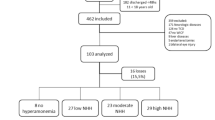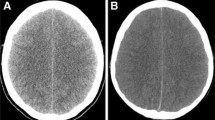Abstract
Background: Ornithine transcarbamylase deficiency (OTCD) is an inborn error of urea cycle resulting in increased plasma levels of ammonia and glutamine and cerebral edema. However, the underlying mechanism of brain cytotoxicity remains controversial. Our objective is to present an unusual acute hyperammonemic crisis suggesting a key role of brain glutamine to mediate ammonia neurotoxicity and the interest of intracerebral pressure (ICP) monitoring to maintain adequate cerebral perfusion pressure and to prevent neurological damages.
Patient: A 6-year-old boy with OTCD was admitted for an acute hyperammonemic encephalopathy following viral infection. At admission, he presented vomiting, confusion, lethargy (Glasgow scale 7/15), and bilateral papilledema, suggesting cerebral edema. Plasma ammonia level was slightly increased (194 μmol/L, rr 25–50 μmol/L), contrasting with the severity of neurological deterioration and with high levels of glutamine in plasma (1,949 μmol/L, rr 335–666 μmol/L) and the brain (10-fold increase on in vivo MR spectroscopy). The patient was placed on neuroprotective treatments and respiratory support.
Main Results: With a hypercaloric protein-free diet and nitrogen scavenger drugs, plasma levels of ammonia and glutamine rapidly decreased without neurological improvement. Continuous ICP monitoring showed repetitive peaks of pressure up to 60 mmHg in the first four days and was helpful to manage neuroprotective treatments. After several days, the patient progressively recovered without cognitive or motor disability.
Conclusion: This case report highlights the discrepancy between the severity of neurological impairment, presumably related to high level of brain glutamine, and plasma levels of ammonia or glutamine in a child with acute hyperammonemic encephalopathy related to OTCD. In this situation, continuous ICP monitoring was helpful to manage neuroprotective treatments and prevent brain damages.
Competing interests: None declared
Access this chapter
Tax calculation will be finalised at checkout
Purchases are for personal use only
Similar content being viewed by others
Abbreviations
- CPP:
-
Cerebral perfusion pressure
- ICP:
-
Intracranial pressure
- OTCD:
-
Ornithine transcarbamylase deficiency
- rr:
-
Reference range
References
Albrecht J, Zielinska M, Norenberg MD (2010) Glutamine as a mediator of ammonia neurotoxicity: a critical appraisal. Biochem Pharmacol 80:1303–1308
Barlow KM, Minns RA (1999) The relation between intracranial pressure and outcome in non-accidental head injury. Dev Med Child Neurol 41:220–225
Braissant O, McLin VA, Cudalbu C (2013) Ammonia toxicity to the brain. J Inherit Metab Dis 36:595–612
Chen CY, Tsai TC, Lee WJ, Chen HC (2007) Aminograms during continuous hemodiafiltration in the treatment of hyperammonemia due to ornithine transcarbamylase deficiency. Ren Fail 29:661–665
Connelly A, Cross JH, Gadian DG, Hunter JV, Kirkham FJ, Leonard JV (1993) Magnetic resonance spectroscopy shows increased brain glutamine in ornithine carbamoyl transferase deficiency. Pediatr Res 33:77–81
Enns GM, Berry SA, Berry GT, Rhead WJ, Brusilow SW, Hamosh A (2007) Survival after treatment with phenylacetate and benzoate for urea-cycle disorders. N Engl J Med 356:2282–2292
Exo J, Kochanek PM, Adelson PD et al (2011) Intracranial pressure-monitoring systems in children with traumatic brain injury: combining therapeutic and diagnostic tools. Pediatr Crit Care Med 12:560–565
Gropman AL, Fricke ST, Seltzer RR et al (2008) 1H MRS identifies symptomatic and asymptomatic subjects with partial ornithine transcarbamylase deficiency. Mol Genet Metab 95:21–30
Haberle J, Boddaert N, Burlina A et al (2012) Suggested guidelines for the diagnosis and management of urea cycle disorders. Orphanet J Rare Dis 7:32
Kamat P, Kunde S, Vos M et al (2012) Invasive intracranial pressure monitoring is a useful adjunct in the management of severe hepatic encephalopathy associated with pediatric acute liver failure. Pediatr Crit Care Med 13:e33–e38
Kojic J, Robertson PL, Quint DJ, Martin DM, Pang Y, Sundgren PC (2005) Brain glutamine by MRS in a patient with urea cycle disorder and coma. Pediatr Neurol 32:143–146
Lichter-Konecki U (2008) Profiling of astrocyte properties in the hyperammonaemic brain: shedding new light on the pathophysiology of the brain damage in hyperammonaemia. J Inherit Metab Dis 31:492–502
Mak CM, Siu TS, Lam CW et al (2007) Complete recovery from acute encephalopathy of late-onset ornithine transcarbamylase deficiency in a 3-year-old boy. J Inherit Metab Dis 30:981
Picca S, Bartuli A, Dionisi-Vici C (2008) Medical management and dialysis therapy for the infant with an inborn error of metabolism. Semin Nephrol 28:477–480
Pichili VB, Rao KV, Jayakumar AR, Norenberg MD (2007) Inhibition of glutamine transport into mitochondria protects astrocytes from ammonia toxicity. Glia 55:801–809
Rabinstein AA (2010) Treatment of brain edema in acute liver failure. Curr Treat Options Neurol 12:129–141
Vaquero J, Fontana RJ, Larson AM et al (2005) Complications and use of intracranial pressure monitoring in patients with acute liver failure and severe encephalopathy. Liver Transpl 11:1581–1589
Wendell LC, Khan A, Raser J et al (2010) Successful management of refractory intracranial hypertension from acute hyperammonemic encephalopathy in a woman with ornithine transcarbamylase deficiency. Neurocrit Care 13:113–117
Zwirner K, Thiel C, Thiel K, Morgalla MH, Konigsrainer A, Schenk M (2010) Extracellular brain ammonia levels in association with arterial ammonia, intracranial pressure and the use of albumin dialysis devices in pigs with acute liver failure. Metab Brain Dis 25:407–412
Author information
Authors and Affiliations
Corresponding author
Editor information
Editors and Affiliations
Additional information
Communicated by: Pascale de Lonlay
Appendices
Conflicts of Interest
The authors declare no disclosure.
Take-Home Message
This case report highlights the key role of brain glutamine to mediate ammonia neurotoxicity in urea cycle disorders and the interest of monitoring intracranial pressure to maintain adequate cerebral perfusion pressure and to prevent neurological damages.
Compliance with Ethics Guidelines
All the authors declare no conflict of interest.
All procedures followed were in accordance with the ethical standards of the responsible committee on human experimentation (institutional and national) and with the Helsinki Declaration of 1975, as revised in 2000. Informed consent was obtained from all patients for being included in the study.
The following are the details of the contributions of individual authors: JC, GF, NF, NRR, TP, and ES for patient management in ICU; MT and FL for metabolic management; NT for surgical placement of intracranial pressure monitoring; and LB and BM for MRI analyses. JC and FL wrote the paper. All coauthors have read the manuscript and approved its submission to the JIMD Reports.
Rights and permissions
Copyright information
© 2015 SSIEM and Springer-Verlag Berlin Heidelberg
About this chapter
Cite this chapter
Chantreuil, J. et al. (2015). Intracranial Pressure Monitoring Demonstrates that Cerebral Edema Is Not Correlated to Hyperammonemia in a Child with Ornithine Transcarbamylase Deficiency. In: Morava, E., Baumgartner, M., Patterson, M., Rahman, S., Zschocke, J., Peters, V. (eds) JIMD Reports, Volume 27. JIMD Reports, vol 27. Springer, Berlin, Heidelberg. https://doi.org/10.1007/8904_2015_486
Download citation
DOI: https://doi.org/10.1007/8904_2015_486
Received:
Revised:
Accepted:
Published:
Publisher Name: Springer, Berlin, Heidelberg
Print ISBN: 978-3-662-50408-6
Online ISBN: 978-3-662-50409-3
eBook Packages: Biomedical and Life SciencesBiomedical and Life Sciences (R0)




